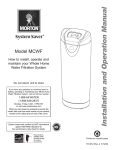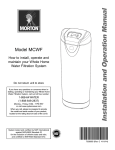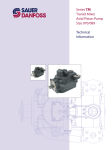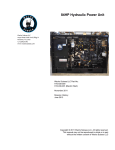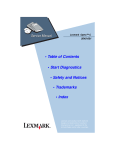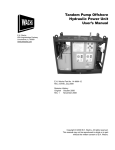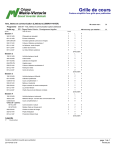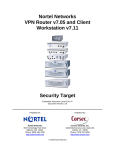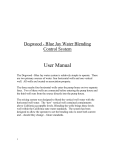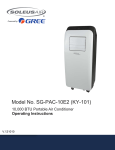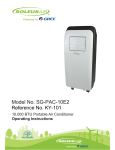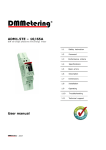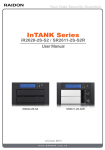Download Operation and Service Manual
Transcript
OPERATION AND SERVICE MANUAL McGILL UNIVERSITY PROJECT: MCS-3237 SUBJECT: HYDRAULIC POWER UNIT AND ROTARY ACTUATORS DECEMBER 2001 MCS-SERVO INC. 1950A, BOUL. MARIE-VICTORIN, ST-BRUNO-DE-MONTARVILLE, QUÉBEC, J3V 6B9 TEL: (450) 653-9465 / FAX: (450) 441-2527 www.mcs-servo.com / [email protected] CONTENTS 1. 1.1. 1.2. 1.3. 1.4. 1.5. 1.6. 2. 2.1. 2.2. 2.3. 2.4. 3. 3.1. 3.2. 3.3. DESCRIPTION OF HYDRAULIC COMPONENTS .................................................. 3 HYDRAULIC POWER UNIT ................................................................................. 3 HEAT EXCHANGER............................................................................................. 4 ACCUMULATOR MANIFOLD............................................................................... 5 ROTARY ACTUATORS........................................................................................ 5 FILTRATION......................................................................................................... 6 RECOMMENDED OIL .......................................................................................... 7 START-UP AND SYSTEM FLUSHING ................................................................... 8 PRELIMINARY INSPECTION............................................................................... 8 START-UP PROCEDURES.................................................................................. 9 SYSTEM FLUSHING ............................................................................................ 9 ADJUSTMENTS ................................................................................................. 12 MAINTENANCE AND REPAIR ............................................................................. 13 COMPONENT REPAIR ...................................................................................... 13 RECOMMENDED MAINTENANCE .................................................................... 14 TROUBLESHOOTING ....................................................................................... 16 4. REPLACEMENT PARTS....................................................................................... 17 5. HYDRAULIC SCHEMATICS ................................................................................. 19 6. TECHNICAL INFORMATION ................................................................................ 23 2 MCS-SERVO INC. 1950A, BOUL. MARIE-VICTORIN, ST-BRUNO-DE-MONTARVILLE, QUÉBEC, J3V 6B9 TEL: (450) 653-9465 / FAX: (450) 441-2527 www.mcs-servo.com / [email protected] 1. DESCRIPTION OF HYDRAULIC COMPONENTS This section of the manual provides a brief description of the main hydraulic components required for the proper functioning of the hydraulic system. Additionally, you will find information regarding the functions and adjustment parameters of the hydraulic components. Refer to section 6 of this manual for a complete technical specifications listing. 1.1. HYDRAULIC POWER UNIT The hydraulic unit is required to operate the two new rotary actuators and the existing one. 1.1.1. OIL RESERVOIR The reservoir required has a capacity of 100 U.S. gallons of hydraulic oil. Two (2) access doors are located on each end the reservoir. One (1) suction port is available for the hydraulic pump. There is one (1) “intank” style filter installed on the top of the reservoir. 1.1.2. HYDRAULIC PUMP The hydraulic power unit has one hydraulic pump, variable flow and pressure compensated type. It will vary the oil flow to keep a constant pressure into the circuit. The pump has a capacity of 21 GPM (gallon per minute) at 1800 RPM. There are three adjustments available on the pump, which are the load sensing, the compensator and the flow limiter. The first adjustment is not used in your system configuration and SHOULD NOT BE MODIFIED. The second adjustment has for function to control the system pressure. AT ANY MOMENT, THE PUMPS’ PRESSURE SHOULD NOT BE UNDER 400 PSI. A pressure under this value will harm to the pump’s lubrication and can damage it. The hydraulic circuit configuration requires a pressure of 3000 PSI. The flow limiter has for function to limit the maximum flow supplied by the pump. For your set-up, this adjustment SHOULD NOT BE MODIFIED. 3 MCS-SERVO INC. 1950A, BOUL. MARIE-VICTORIN, ST-BRUNO-DE-MONTARVILLE, QUÉBEC, J3V 6B9 TEL: (450) 653-9465 / FAX: (450) 441-2527 www.mcs-servo.com / [email protected] (flow limiter on back, not shown on this picture) 1.1.3. ELECTRIC MOTOR A 40 HP at 1800 RPM, 3 phase, 600 volt motor is required to drive the pump. 1.1.4. RESERVOIR ACCESSORIES To complete the H.P.U., the reservoir must be equipped with some other accessories. These are : a breather, one (1) temperature switch, a level and temperature indicator, one (1) electric level indicator, one (1) suction strainer and two (2) ball valves to fill and drain the reservoir. 1.2. HEAT EXCHANGER In order to extract the heat transmitted to the hydraulic fluid, the oil must circulate through a oil/water type cooler. The oil coming from the return line will pass through the cooler. If the pressure increases and reaches 30 PSI, due to the restriction made by the cooler, the excess of flow will bypass the cooler by the check valve installed in parallel. A thermostatic valve senses the oil temperature into the reservoir and control the water flow going to the cooler. A solenoid valve, installed upstream of the thermostatic valve, will close and block the water going to the cooler, when the hydraulic power unit will stop. 4 MCS-SERVO INC. 1950A, BOUL. MARIE-VICTORIN, ST-BRUNO-DE-MONTARVILLE, QUÉBEC, J3V 6B9 TEL: (450) 653-9465 / FAX: (450) 441-2527 www.mcs-servo.com / [email protected] 1.3. ACCUMULATOR MANIFOLD To ensure a stable pressure, an accumulator is installed on the pressure line. The accumulator manifold has a pressure relief valve and a dump valve. The pressure relief valve’s function is to protect the circuit in case of too high pressure. The dump valve is a normally opened solenoid valve, which is energized when the hydraulic pump is turned on. If the pump is stopped, all the pressure contained in the pressure line and the accumulator is dumped to the reservoir. An orifice downstream the dump valve prevents shocks into the return line by limiting the flow going to the reservoir. A pressure test point is available to measure the supply pressure. The diaphragm type accumulator is connected to the accumulator manifold. The nitrogen pressure is 2400 PSI. It should be at approximately 80% of the system pressure. 1.4. ROTARY ACTUATORS The actuators supplied are equipped with a Moog proportional valve, a pressure reducing valve, a cam, a directional valve mechanically activated and a potentiometer. OBSOLETE 1.4.1. Moog proportional valve The Moog D681-4718 is a proportional valve, 4 way, 10% overlap and linear flow characteristic. The command signal is +/-10 Volts and the feedback is +/-10 Volts with dead band compensation. The valve’s electronics will compensate for the 10% overlap of the spool. The valve is also equipped with an electrical fail-safe. In order to move the spool to the safe centered position, the two control chambers of the main stage are hydraulically short circuited by a 4 way / 2 positions solenoid valve. The spring force move the spool into overlapped centered position. 5 MCS-SERVO INC. 1950A, BOUL. MARIE-VICTORIN, ST-BRUNO-DE-MONTARVILLE, QUÉBEC, J3V 6B9 TEL: (450) 653-9465 / FAX: (450) 441-2527 www.mcs-servo.com / [email protected] 1.4.2. Pressure reducing valve The pressure reducing valve can be used to reduce pressure downstream of it. By reducing the pressure supplied to the actuator, the maximum torque applied by the actuator is reduced. For maximal performances, the pressure should be 3000 PSI. 1.4.3. Directional valve The directional valve mechanically operated function is to block the pressure going to the Moog proportional valve if it is activated by the cam. 1.4.4. Cam The cam has been machined to allow a rotation of +/-20 degrees. 1.4.5. Potentiometer The potentiometer has a 5K resistance and the theoretical electrical travel is 340 degrees +/-5 deg. 1.5. FILTRATION The hydraulic system has two types of filtration. There are the high pressure and the low pressure filters. All original filter assemblies are equipped with filtration elements rated at 99.5% efficiency (ß3 ] 200). The filters are equipped with electrical clogging indicators. These indicators can either be normally opened or normally closed. They give an indication of the filtration elements condition. The indicators will shift when the pressure differential between the inlet and the outlet exceeds approximately 116 PSI for the high pressure filter and 32 PSI for the low pressure filter. Generally, when an indicator shifts the electrical logic, it means that the filter element needs to be changed. However, when starting up during cold conditions, the oil has a higher viscosity rating than it would during normal temperature operating conditions. The higher viscosity rating could have the same effect on the indicator as a clogged filter element. To avoid changing filter elements 6 MCS-SERVO INC. 1950A, BOUL. MARIE-VICTORIN, ST-BRUNO-DE-MONTARVILLE, QUÉBEC, J3V 6B9 TEL: (450) 653-9465 / FAX: (450) 441-2527 www.mcs-servo.com / [email protected] unnecessarily, we recommend that the indicators be checked only when the system reaches a normal operating temperature. The return (or low pressure) filter is equipped with a bypass mechanism for the filter element. This mechanism opens only when the pressure differential pressure between the filter’s inlet and the outlet is 51 PSI. This is used to protect the filter element against high pressure which could damage it or collapse it. Even though the indicators seem to indicate that the filter elements are still good, we strongly recommend to change the elements at regular intervals (e.g., during a regularly scheduled shut-down or approximately every 6 months). 1.5.1. HIGH PRESSURE FILTRATION The high pressure filter is installed at the pump’s outlet and is “nonbypass” type. It features a 3000 PSI collapse rating which will eliminate all possible contamination risks downstream the filter. The element is rated at 3 micron absolute (ß3 ] 200). 1.5.2. LOW PRESSURE FILTRATION The low pressure filter is installed on the H.P.U.. It has a bypass valve prevent back-pressure in the return line which could damage the filtration element. The element is rated at 3 micron absolute (ß3 ] 200). 1.6. RECOMMENDED OIL There are several types of oil available on the market. That which concerns us is oil designed for hydraulic systems. In this category, oils are classified according to their viscosity and the additives contained therein. For your hydraulic system, we recommend Shell Tellus 32, Tribospec Corporation’s Sunvis 700, or all equivalent oils. Because of certain components construction and precision machining of internal parts, the system’s oil must be maintained at a certain cleanliness level. According to ISO code DIS 4406 (SAE J1165), Moog recommends ISO cleanliness level of 14/11 (or better) with a maximum of 16/13 for all servovalves and proportional valves. Hydraforce recommends a cleanliness level of ISO code 18/14 for its cartridge valves. ISO code 14/11, being the most stringent of the hydraulic system, is therefore the cleanliness level to be maintained in order to maximise both system performance and component life. The efficiency level of the hydraulic system is directly linked to the overall performance. 7 MCS-SERVO INC. 1950A, BOUL. MARIE-VICTORIN, ST-BRUNO-DE-MONTARVILLE, QUÉBEC, J3V 6B9 TEL: (450) 653-9465 / FAX: (450) 441-2527 www.mcs-servo.com / [email protected] 2. START-UP AND SYSTEM FLUSHING The recommendations which follow concern the start-up procedure. This procedure must be followed after every prolonged system shut-down and especially following repairs to the system. 2.1. PRELIMINARY INSPECTION Prior to engaging the electric motor: - Check fluid level in the reservoir. The level must be near the upper limit of the level indicator. Top up, if necessary, with clean and filtered fluid (the use of a portable filtration unit, available at MCS-SERVO INC., is strongly recommended). - Verify that pump housing is filled with fluid. Unscrew the upper-most fitting on the pump. If required, fill with clean fluid. - If the pump has been repaired or replaced, make sure that it has been properly mounted on the electric motor, that all connections have been tightened, and that the pressure compensator screw has been properly adjusted. - Check accumulator precharge pressure. It should be approximately 2400 PSI. Use a charging unit (available at MCS-SERVO INC.). - If a component has been removed for repair or replacement, ensure that it has been properly reinstalled according to schematic specifications, material lists, or to specific mounting instructions. - If a hydraulic line has been disconnected, ensure that it has been correctly reinstalled according to specifications or to proper installation procedure. 8 MCS-SERVO INC. 1950A, BOUL. MARIE-VICTORIN, ST-BRUNO-DE-MONTARVILLE, QUÉBEC, J3V 6B9 TEL: (450) 653-9465 / FAX: (450) 441-2527 www.mcs-servo.com / [email protected] 2.2. START-UP PROCEDURES NOTE : Read section 2.3 if a flushing is required for a part of the system or section 2.4 for the whole system if some components requires settings. Connect the 0-3000 PSI gauges to the test points located on the accumulator manifold. Start the electric motor. - If work has been carried out on the motors' electric line, verify its rotation. Remove the plastic cover located on the pump/motor adapter and, using a marker, indicate the direction of rotation. Effect short "start-stop" sequences to confirm motor rotation. For a pump with a clock-wise rotation, the motor's rotation will usually be the opposite (i.e., counter-clockwise). A pump's rotation must always be checked with the shaft facing the technician. If required, the motor's rotation may be changed by inverting the two wires in the feed cable (check rotation again). Replace plastic cover. - Re-initiate short "start-stop" sequences to charge the pump. Check for fluid leaks and/or unusual noises and correct as required. Also check the gauge's needle. The pump must operate smoothly under stable pressure after charging. - Pay particular attention to start-ups effected under cold conditions : Cold fluids are very viscous and could cause premature pump wear or breakdown. Startups are not recommended when system fluid temperature is inferior to 10 °C (50 °F). - Keep watch of the reservoir's fluid level. Fill as required with clean and filtered fluid (see section 2.1). 2.3. SYSTEM FLUSHING A system flushing is required if a repair is made on a hydraulic component located upstream a sensitive component to the contamination which there can be in oil. A premature start-up without proper flushing could lead to costly repairs as well as a loss of production time. While most major fluid suppliers offer specially-designed fluids exclusively for hydraulic system flushing, standard system fluid may be used for flushing so 9 MCS-SERVO INC. 1950A, BOUL. MARIE-VICTORIN, ST-BRUNO-DE-MONTARVILLE, QUÉBEC, J3V 6B9 TEL: (450) 653-9465 / FAX: (450) 441-2527 www.mcs-servo.com / [email protected] long as it is initially clean. Best results are achieved when the system fluid temperature is high and the flow is turbulent. 2.3.1. PREPARATION FOR SYSTEM FLUSHING While a system flushing is a procedure which requires a certain amount of preparation, it plays an important role in ensuring prolonged life for the implicated components. If the flushing procedure is improperly carried out or ignored, components in the hydraulic circuit may become damaged. The following are the recommended steps to follow for a proper flushing: 1) Install a flushing element in the high pressure filter assembly. We suggest elements rated at 3 microns absolute. 2) Replace the return line filter element with new element. Again, We suggest elements rated at 3 microns absolute. 3) Isolate all proportional valves in the circuit being rinsed. This may be achieved by any of the following methods : a) Replacing the proportional valves by directional valves; b) Replacing the proportional valves by specially-designed rinsing plates; Note : We suggest that the proportional valves be properly stored in sealed plastic bags whenever removed from their manifolds. c) Linking the pressure (P) line to the return line (T) leading to the manifolds of the particular valve to be isolated. 4) Heat the reservoir oil to approximately 50 °C (122 °F) if required. To do so, follow the instructions as listed in 3). If option 3a) has been undertaken, then proceed according to 4a) – if not, proceed according to 4b). a) Start the pump and adjust the pumps’ compensator to approximately 500 PSI (see the notes lower). Activate each of the directional valves so as to ensure proper circulation of the oil in the circuit. Leave circulate for about 1.5 to 2 hours. 10 MCS-SERVO INC. 1950A, BOUL. MARIE-VICTORIN, ST-BRUNO-DE-MONTARVILLE, QUÉBEC, J3V 6B9 TEL: (450) 653-9465 / FAX: (450) 441-2527 www.mcs-servo.com / [email protected] b) Close the pressure ball valve at pump outlet as well as the one at the low pressure filter’s inlet. Adjust the pump compensators to approximately 500 PSI. Completely open the pressure valve first. Then, slowly open the return valve until the pressure equals the pump’s pressure or until the pump starts to “grumble”. In the case of the latter condition, close the return valve until the pump begins to operate normally. Leave circulate for about 1.5 to 2 hours. Notes : - It is important to reduce system pressure to approximately 500 PSI to reduce the possibility pressure spikes in the system and to avoid damaging the rinsing elements; - Regularly verify the pump’s pressure because, as the oil temperature rises, viscosity diminishes therefore causing pressure to drop. The pump’s pressure should never go under 400 PSI under risk to damage the pump; - Regularly check oil level in the reservoir if a major intervention occurred in the system and a large quantity of air has been introduced in the piping. Add clean oil as required. 5) Stop the system and allow the oil to cool. 6) Change rinsing element for a new high pressure filter element (see section 4). 7) Change the return filter element (low pressure) for new filter element (see section 4). 8) Re-install the proportional valves or reconnect the hoses to their original positions. 9) Completely open the return line ball valve and completely close the ball valve on the pressure line. 10) Re-start the pump and re-adjust the pump compensator to its original value. 11) Slowly open the pressure line ball valve to pressurize the system. 12) Re-verify reservoir oil level. 11 MCS-SERVO INC. 1950A, BOUL. MARIE-VICTORIN, ST-BRUNO-DE-MONTARVILLE, QUÉBEC, J3V 6B9 TEL: (450) 653-9465 / FAX: (450) 441-2527 www.mcs-servo.com / [email protected] Note : It is important to keep all affected areas, components, and personnel involved with the flushing as clean as possible. It is imperative to undertake all possible precautions to avoid contaminating the components or the hydraulic circuit with foreign particles or with liquid other than the hydraulic fluid being utilised. 2.4. ADJUSTMENTS The hydraulic system uses some components that requires adjustments (like pressure, flow and temperature) and those adjustments can be modified to obtain the best system’s performances. The hydraulic system can be considered as a prototype during the start up. The following adjustments are suggested to obtain good performances. However, during start up, some re-adjustments should be necessary. Refer to section 5 for parts listing and section 6 for all technical details. 2.4.1. ADJUSTABLE COMPONENTS ON THE H.P.U. Components featuring adjustments on the hydraulic power unit (H.P.U.) are the pump’s compensator, the temperature switch, the relief valve and the thermostatic valve. 2.4.1.1. PUMP’S COMPENSATOR ADJUSTMENT On the pressure compensated pump, two adjustments are possible. One adjustment is the maximum flow that the pump can supply while and the other is the system pressure (see section 1.1.2). - Pump pressure compensator : This is used to limit the system pressure. For ideal system performance, the pressure compensator must adjusted at 300 PSI. The maximum pressure adjustment can be up to 4000 PSI. - Pump flow limiter : This is used to limit the flow supplied to the system. This adjustment requires the use of a flow meter. This adjustment must therefore be carried out by qualified personnel using the proper 12 MCS-SERVO INC. 1950A, BOUL. MARIE-VICTORIN, ST-BRUNO-DE-MONTARVILLE, QUÉBEC, J3V 6B9 TEL: (450) 653-9465 / FAX: (450) 441-2527 www.mcs-servo.com / [email protected] equipment. Consequently, this adjustment must not be modified (original adjustment). 2.4.1.2. TEMPERATURE SWITCH There is one temperature switch installed on the reservoir. It should be set at 65 °C (150 °F). Its function is to shut down the hydraulic system in order to avoid causing damage to the circuit’s components due to over-heating problem. 2.4.1.3. THERMOSTATIC VALVE The thermostatic valve regulates the water flow going through the oil cooler. It can be adjusted between 1 and 5 which corresponds to the opening temperature to allow the water going to the cooler. The numbers 1 is equivalent to 25 °C (77 °F) and 5 is equivalent to 65 °C (150 °F). The valve is set at 3 (110 °F). 3. MAINTENANCE AND REPAIR The trouble-free functioning of a hydraulic system begins with proper maintenance and adequate repair of system components when required. However, as is true with all machines, some components may break down without notice. System performance may be severely compromised due to improper use or incorrect settings. Section 3.3 describes some of the most common problems that may occur in the hydraulic system. 3.1. COMPONENT REPAIR Some components (e.g., reservoir accessories, cartridge valves, other standard valves, strainers, etc.), because of their relatively low cost, may not be economically repairable. Other components, such as accumulators, oil coolers, filter heads, and flow regulators are not prone to breakdown if they are used under normal operating conditions. Even such components such as pumps, solenoid valves, servovalves and cylinders should be replaced by new units in case of breakdown in order to 13 MCS-SERVO INC. 1950A, BOUL. MARIE-VICTORIN, ST-BRUNO-DE-MONTARVILLE, QUÉBEC, J3V 6B9 TEL: (450) 653-9465 / FAX: (450) 441-2527 www.mcs-servo.com / [email protected] reduce down-time. By using this strategy, the defective units may be repaired and subsequently be used as spares. Section 6 provides a detailed description of these components along with the related technical information required to repair the defective parts. Section 4 provides a partial list of the most commonly required replacement parts. The manufacturer recommends that these parts should be kept in stock as their failure is one of the major causes of system stoppages. The repair and reconditioning of the majority of the system's components must be undertaken by qualified technicians in a clean and well equipped environment designed for that purpose. If your personnel does not have these qualifications, it is recommended that the components be forwarded to a hydraulics specialist (i.e., MCS-SERVO INC.). 3.2. RECOMMENDED MAINTENANCE The principle source of system stoppages in hydraulic systems is dirt (e.g., dust) and most particularly fluid contamination. A clean system operating in a clean environment will function for longer periods of time with greater performance and efficiency. Therefore : - Change filter elements regularly (e.g., every 2000 hours of operation or once par year) or when notified by the status of filter indicators. Even though changing elements may require that the system be shut down, the little time this action take could very well save hours or even days of down time caused by contaminated pumps or servovalves. Note : During cold condition start-ups, filter indicators may indicate that the elements are obstructed. This is caused, however, by the fluid's high viscosity. The filter indicators must therefore only by considered when fluid temperature nears normal operating levels (30 °C). - Keep the system clean. Do not allow dust or foreign materials to accumulate on components or hoses and most particularly on the top of reservoirs in which particles may fall into during inspections or opening of the breather cap. Stop leaks as soon as they are detected. Not only will leaks cause fluid loss, but dust particles will 14 MCS-SERVO INC. 1950A, BOUL. MARIE-VICTORIN, ST-BRUNO-DE-MONTARVILLE, QUÉBEC, J3V 6B9 TEL: (450) 653-9465 / FAX: (450) 441-2527 www.mcs-servo.com / [email protected] also be introduced into the system. Problems may be more easily pin-pointed and solved when a system is kept clean. - If the system's environment is excessively dirty, precise measures must be taken to prevent dirt from accumulating and gaining access to the system through the breather cap. - Two other major causes of hydraulic system shut-down or loss of performance are excessive fluid temperatures and insufficient fluid levels in the reservoir. - Do not allow the system to operate at an excessively high temperature (e.g., greater than 65 °C (150 °F)). High temperatures lead to the following problems : Low fluid viscosity and degradation, an increase in internal leaks, acceleration of component wear, reduction in the joints' useful operating life, modification of valve function, etc. It is important to locate problems and to correct them immediately. We also recommend to daily check the following points. This will enable you to make a certain preventive maintenance on the machine. - An inspection of the reservoir (for any openings on the surface); - A cursory inspection of all manifold hoses and tubing for any apparent leaks; - List any and all abnormal noises, shocks or vibrations in the conduits; - Make a report of all mechanical problems (e.g., excessive friction, jerky or abrupt movements, etc.). As was mentioned in section 2.3, a complete system flushing should be undertaken after a stoppage caused by the breakdown of a component. A partial flushing is sufficient if the breakdown occurs past the component's protection filter. A complete system cleaning and flushing should be undertaken at least once per year. Carefully inspect and clean all components and repair or replace any defective part to keep the system functioning at perk performance levels. 15 MCS-SERVO INC. 1950A, BOUL. MARIE-VICTORIN, ST-BRUNO-DE-MONTARVILLE, QUÉBEC, J3V 6B9 TEL: (450) 653-9465 / FAX: (450) 441-2527 www.mcs-servo.com / [email protected] 3.3. TROUBLESHOOTING This section lists the major causes of the most frequently encountered hydraulic system breakdown problems (consult a hydraulics specialist, e.g., MCS-SERVO INC., for problems not listed below). The first step in diagnosing any system problem is to start looking for the furthest point up the line (from the pump) where it is known that the system is functioning properly. Afterwards, follow the flow's direction and effect a component-by-component check until the faulty part is located. ABSENCE OF FLOW: - The electric motor(s) is (are) not functioning; - The pump is not coupled to the electric motor; - Fluid level is low; - The pump is not primed; - The pump is defective; - The flow regulating valve(s) on the manifold is (are) not completely open or closed. FLOW IS WEAK: - The pump is defective; - A component of the hydraulic circuit leaks. ABSENCE OF PRESSURE: - Absence of flow (see above); - The pump is defective; - The pressure regulating valve is either completely open or adjusted too close to the recommended minimum pressure. LOW PRESSURE: - The pressure compensator's adjustment is too low; - The pump is defective; - The pressure regulating valve is either adjusted too low or partially open. NOISY OPERATION: - Fluid temperature is too low (cavitation); - Breather is obstructed (cavitation); - Strainer is obstructed (cavitation); 16 MCS-SERVO INC. 1950A, BOUL. MARIE-VICTORIN, ST-BRUNO-DE-MONTARVILLE, QUÉBEC, J3V 6B9 TEL: (450) 653-9465 / FAX: (450) 441-2527 www.mcs-servo.com / [email protected] Pump suction valve is partially closed (cavitation); Fluid level in reservoir is too low (aeration); Connections improperly fastened on the suction line (aeration); Pump is worn; Couplings worn or improperly fastened; Incorrect pump rotation; The pressure regulating valve is adjusted lower than the pump pressure compensator setting; - Pressure regulating valve and pressure compensator settings have near or similar values; - SYSTEM OVERHEATING: - The heat exchanger is blocked; - The oil does not circulate in the cooler; - The cooler fan is either blocked or is turning in the wrong direction; - Heat exchanger intake air is too hot; - The cooler's starter switch is set to high; - The temperature probe is not in the reservoir; - Ambient air temperature is too high; - Fluid level is too low; - Cavitation or excessive aeration (see "NOISY OPERATION"); - The pressure regulating valve is set below the pump's pressure compensator setting; - Excessive fluid leaks aft of the system components. 4. REPLACEMENT PARTS A comprehensive inventory of replacement parts may initially seem to be an excessive expense... until a problem arises. Stocking replacement parts can, therefore, facilitate repairs and decrease downtime due to long delivery delays for certain components. This investment can pay for itself, by decreasing downtime, after as little as one repair. The table, following on the next pages, indicates for each important parts its location on the machine, its importance in the event of breaking, the standard delivery time and the quantities which we suggest having in stock. 17 MCS-SERVO INC. 1950A, BOUL. MARIE-VICTORIN, ST-BRUNO-DE-MONTARVILLE, QUÉBEC, J3V 6B9 TEL: (450) 653-9465 / FAX: (450) 441-2527 www.mcs-servo.com / [email protected] Part number Description Sugg. quantities BEPI2230 BEPI2130 BEPI21040RN 6366115 SV10-21-0-N-00 SV16-20-0-N-00 CV16-20-0-N-05 RV50-22A-0-P-50 LS1800-01801 4WMR10C3X PBFB-LAN 112P1952 High pressure element 3 microns Flushing element for high pressure filter Return filter element 3 microns Coil for Hydraforce solenoid valve Hydraforce solenoid valve Hydraforce solenoid valve Hydraforce check valve Hydraforce relief valve Electrical level switch Directional valve Pressure reducing valve Potentiometer 5K 1 1 1 1 1 1 1 1 1 1 1 1 18 MCS-SERVO INC. 1950A, BOUL. MARIE-VICTORIN, ST-BRUNO-DE-MONTARVILLE, QUÉBEC, J3V 6B9 TEL: (450) 653-9465 / FAX: (450) 441-2527 www.mcs-servo.com / [email protected] 5. HYDRAULIC SCHEMATICS 19 MCS-SERVO INC. 1950A, BOUL. MARIE-VICTORIN, ST-BRUNO-DE-MONTARVILLE, QUÉBEC, J3V 6B9 TEL: (450) 653-9465 / FAX: (450) 441-2527 www.mcs-servo.com / [email protected] HP020 FWD Flow 1 Pressure Valve-X FWD Flow 2 OBSOLETE 6. TECHNICAL INFORMATION In this section, you will find all the information about the important parts and components of the hydraulic circuit. 23 MCS-SERVO INC. 1950A, BOUL. MARIE-VICTORIN, ST-BRUNO-DE-MONTARVILLE, QUÉBEC, J3V 6B9 TEL: (450) 653-9465 / FAX: (450) 441-2527 www.mcs-servo.com / [email protected]























